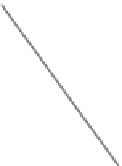Biomedical Engineering Reference
In-Depth Information
Fig. 24.5
Postulated models for cortical folding. (
A
) Intracortical differential growth hypothe-
sis (Richman et al.,
1975
). Brain cortex is divided into two layers with the outer layer growing
faster (indicated by
+
+) than the inner layer (+). Underlying tissue does not grow (
0
). Differential
growth results in cortical buckling. (
B
) Axon tension hypothesis (Van Essen,
1997
). Tension (
black
arrows
) in axons pulls two cortical regions together to form an outward fold. The inward fold that
forms between the outward folds separates weakly interconnected cortical regions (
grey arrows
).
(
A
) Phased differential growth model. Cortical growth in region 1
(t <t
c
)
followed by cortical
growth in region 2
(t >t
c
)
produces two folds. The underlying subplate grows to relax the induced
stresses. (
B
) Experimental distributions of axon tension. Axons are under tension (
black arrows
)
and aligned in the directions shown. Importantly, no circumferential tension (
grey arrows
) or axons
(
grey dotted lines
) were detected in the cores (subplate) of the outward folds. (
C
-
C
) Correspond-
ing finite element model for cortical folding caused by phased differential growth. The
dark
and
light grey colors
indicate circumferential tension and compression, respectively (Xu et al.,
2010b
).
Figure reproduced from Xu et al. (
2010b
), with permission from the Journal of Biomechanical
Engineering, ASME
by combined osmotic expansion and artificially applied loads and constraints. It is
important to note, however, that these models focus mainly on folding geometry and
do not present stress distributions, which can be used to help distinguish between
multiple solutions.
In an alternative hypothesis, Van Essen (
1997
) has postulated that the brain ex-
pands due to hydrostatic pressure and growth, but tension in axons restricts this
expansion locally, forcing the cortex to fold (Fig.
24.5
B). Consistent with obser-
vations, such a mechanism would tend to create outward folds in regions that are
strongly interconnected, producing compact wiring, whereas inward folds form in































































































































































